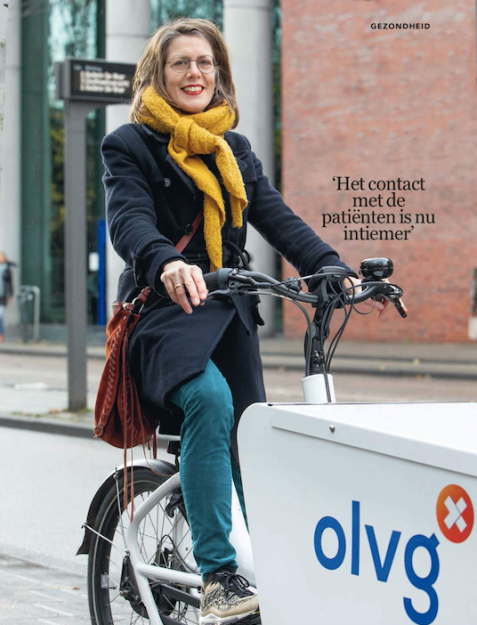
Genealogiecode: K XI w.8
Door: Marte van Santen
Bron: Plus Magazine.nl
Foto: Cees Rutten
More and more cancer patients can – if they want – get their treatment at home. An oncological nurse and two patients explain how it works. Since June last year a very eyecatching contraption graces the streets of Amsterdam: a hospital cargo-bike. Four oncological nurses of the OLVG (Amsterdam city hospital) can use it to visit and treat their patients at home. Two days a week, no matter the weather, they bike through the city, the cargo bike loaded with a well-fill backpack, a collapsible drip, and a special chemo waste bin. “I biked 32 kilometers (20 miles) in one day a while ago,” Laura Vreugdenhil (54), one of the oncological nurses who participate. “In the pouring rain! Luckily our carge bike is electric-driven ánd we’ve got proper rain suits.”
Pills, injections or infusion pump
Those who receive chemo or immunotheraphy often have to visit the hospital for a long time. Especially if the patient’s health deteriorates those visits can be very demanding. In some of those instances home-treatment is the solution. There are various ways of doing it: more and more cancer medication can be taken in the form of pills. And then there’s the elastomer pump, a type of small bottle with chemo medication that slowly empties itself into the patient, which is used certain types of chemotheraphy that has to take several days to slowly administer. Usually the hospital admits patients who use that type of treatment, but with one of those portable bottles they can go back home to finish the treatment after being connected to it in the hospital. In general patients needs four to twelve of these treatments. And when they can do the majority of those at home, then it’ll significantly reduce the number of days in hospital.
Half hour
The number of patients nurse Laura Vreugdenhil visits at home is different each day. The planning department gives her a pre-planned route in advance so that she doesn’t have to bike through the city the whole day. “I start my day with reading the patients’ notes. After that I load up the cargo bike with my equipment and hit the road. The phone connected to a holder on the handlebar of the bike lets me know where to go.” For a patient with multiple myeloma – better known as Kahler’s disease – Vreugdenhil administers injections with chemotheraphy. A woman with breastcancer gets a drip with bone-strengthening medication. A man with bowel cancer is given a elastemer pump that he has to carry with him for two days. Each of those treatments doesn’t take more than half an hour to administer – the time Vreugdenhil usually is allotted per patient. In advance of the home-treatment the patients have been given extended explanations of their treatment in hospital. The medication used is very poisonous, and especially when they’ve got other people living with them, they need to be very careful. Therefore they’ve been given the advice to flush the loo twice after using it. That way the other people have a smaller chance to come into contact with the rest-products of the medication.
Free choice
Mid-treatment evaluation has shown that the patients who participate in the OLVG-trial are very enthusiastic. They give the cancer-healthcare a B+. But not everyone is comfortable with the idea. In 2018 the Dutch Federation for Cancer-patient organizations (NFK: Nederlandse Federatie van Kankerpatiëntenorganisaties) performed a survey among 738 (ex) cancer patients. Of them 24% preferred at home treatments, 35% chose hospital treatment (the most important reason being the feeling of safety attached to hospital treatment). The remaining people would rather use both interchangeably. In the end the choice is always made by the patients, something both hospitals and health insurance companies that provide home treatments emphasize. Nurse Vreugdenhil is one of those that’s very happy with the extra service for patients. “For some patients the constant hospital visits can be an enormous task – both physically and mentally,” she says. “And in those cases it’s a huge plus that the treatments can be done at home.” Laura herself says it’s a welcome change to her already varied work-roster. “I’m used to only seeing patients in hospitals. And now I visit them at home and get to know them in an entirely different capacity. For just half an hour each time I enter their daily lives and am able to give them my undivided attention. This makes for very close contact and very interesting conversations. Patients also see me from an entirely different side, like a while ago when the zipper of my rain coat was stuck and I couldn’t get the coat off, we were able to laugh about it together.
Complications
Since the start of the trial in June 2018, none of the OLVG-patients have had any unexpected complications. “Of course we only made the decision after careful deliberation,” Vreugdenhil says. “Patients always get their medication administered at hospital the first few times in order to see how they react to it. Only then we’ll start talking about bringing them the at-home care. And the patient-nurse lines are incredibly short: patients can call us night and day if they’ve got any questions or worries.” At this moment in time not every type of chemo- or immunotherapy cannot be given at home. An example of this is is medication that needs to be administered via drip within a few hours under strict nurse-supervision, that still needs to be done at hospital. But expectations are that the home treatment options will increase quickly. Of course it would be excellent that one day every cancer patient who wants to (and for whom it’s safe to do so) to get their medication at home.
